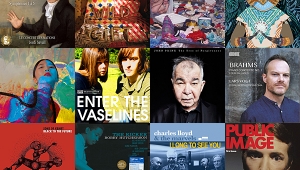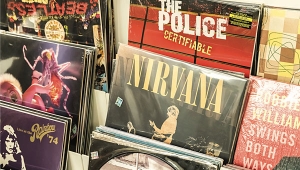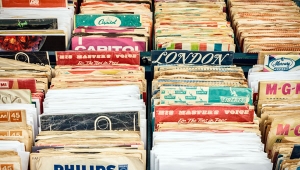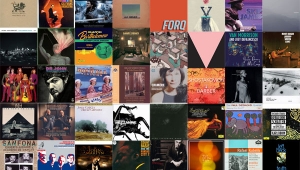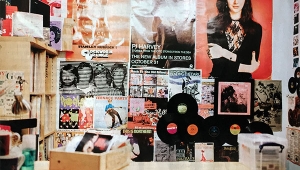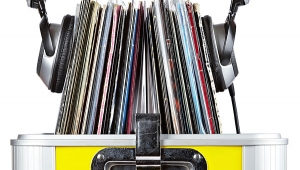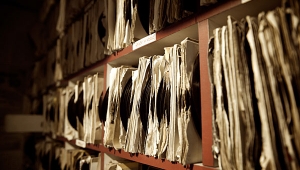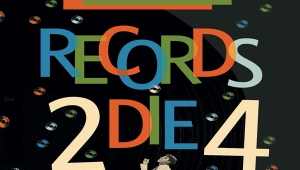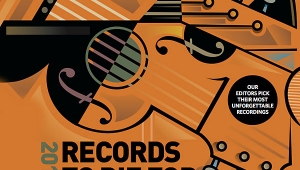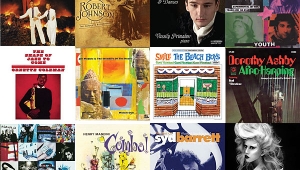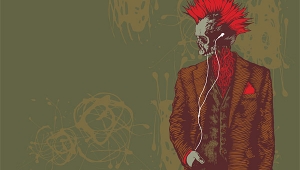| Columns Retired Columns & Blogs |
1993 Records To Die For Page 8
Peter W. Mitchell
VAUGHAN WILLIAMS: Fantasia on a Theme by Thomas Tallis, Fantasia on "Greensleeves"
ELGAR: Serenade in e, Introduction & Allegro for Strings, Elegy, Sospiri
Sir John Barbirolli, Sinfonia of London, Allegri Quartet
EMI CDC7-47537-2 (CD; LP version available only in the UK). AAD. TT: 57:47
The heart of this disc is the 16-minute Tallis Fantasia, played by three antiphonal groups of string instruments: a quartet, a chamber orchestra, and an octet. In some performances they are separated left-to-right, but in this 1963 recording they are arrayed front-to-back. Crossed-pair Blumlein miking yields a very deep soundstage, with the quartet down front and the octet far away. Thanks to the music's modal harmonies and the frame of churchly ambience, some of the octet's chords sound as if they came from a pipe organ. Many recordings of this piece are lovely, but in Barbirolli's sensitive phrasing and dynamic shadings I hear the slow pulse and breath of a universal soul. This disc tops my island-treasures list because, during 25 years of hearing it via LP and CD, I have frequently experienced an ecstatic mystical trance. A few other pieces of music have evoked a similar result, but none as consistently as this.
ENYA: Watermark
Reprise 26774-2 (CD only). Nicky Ryan, prod.; Ross Cullum, eng. AAD. TT: 43:08
Is it redundant to recommend a worldwide hit? A year ago (Vol.15 No.2, p.209), RL praised the remarkable grace and beauty of Enya's Shepherd Moons, but I find myself returning more often to her best-selling Watermark, which has the same qualities plus a greater variety of mood and sound (including strong 28Hz pulses that set both my subwoofers and my toes to dancing). The solo voice also sounds more attractively natural here than on Shepherd Moons, where its brightness and prominence aid in following the lyrics. The music might be described as Gaelic folk/pop ballads in "New Age" dress, a genre that I pronounced like "sewage" until I heard this disc.
Thomas J. Norton
PIERRE BARDON: Les Organistes du Roy Soleil
Works by Clerambault, D'Andrieu, Marchand, Raison Pierre Bardon, royal organ of Saint-Maximin-en-Provence Pierre Verany PV.784011 (CD only). DDD. TT: 55:37
Among the fair number of organ recordings in my collection, this CD is unique. The instrument itself is magnificent; its distinctive signature is its top end, including a striking array of 27 trumpet pipes. A friend for whom organ recordings never have enough highs had no complaint about this disc. In fact, if there is a flaw, it's a sometimes overly vigorous rendering of that high end, which tends toward a bit of hardness in this less than recent CD. (No date, but I've owned it for at least five years.) The lush acoustic of St. Maximin has a long reverberation time, but the sound never becomes muddled.
ALL STAR PERCUSSION ENSEMBLE
Bizet: Carmen Fantasy. Beethoven: Scherzo from Symphony 9. Pachelbel: Canon in D. Berlioz: "March to the Scaffold" from Symphonie Fantastique
Harold Farberman, arr. & cond.
MMG MCD 10007 (CD only). Tom Lazarus, MacDonald Moore, engs. DDD. TT: 42:26
My reaction to these adaptations for percussion ensemble of standard orchestral repertoire was first curiosity, then delight. This is no Spike Jones-style sendup; Farberman's arrangements are serious and fun at the same time, and work on almost every level. Who says classic works should never be looked at in new ways?
Dick Olsher
BEETHOVEN: Symphony 9
René Leibowitz, Royal Philharmonic
Chesky CD66 (CD only). K. E. Wilkinson, eng.; Charles Gerhardt, prod. (Reissue: Jeremy Kipnis, tech. dir.; David & Norman Chesky, prods.) ADD. TT: 61:57
Every great conductor, from Bernstein to Stokowski, has left us with a memorable interpretation of this milestone in western music. It is within this esteemed arena that Leibowitz and the RPO make a statement. The pacing is just to my liking, and expertly unfolds the emotional spectrum of the music---from spiritual to joyous. Above all else, the orchestra, chorus, and soloists display an infectious enthusiasm that gives the music a welcome freshness.
MUDDY WATERS: Folk Singer
Muddy Waters, vocals, guitar; Buddy Guy, guitar; Willie Dixon, bass; Clifton James, drums
MCA/Chess CH-9261 (LP). Ron Malo, eng.; Ralph Bass, Willie Dixon, prods. (Reissue: Bob Schneiders, prod.) AAA. TT: 44:24
McKinley Morganfield, better known as Muddy Waters, returned to his roots in this all-acoustic album, originally cut in 1963. A young Buddy Guy took part in the session, either backing Muddy or playing solo. The synergy between Muddy and Buddy provides an additional spark which marks this album for musical distinction. This is blues, pure and simple.
Michael Ross
RENÉ GEYER: René Geyer
Portrait ARR 37949 (LP only). Rob Fraboni, prod.; Ricky Fataar, co-prod.; Jim Kramer, eng. AAA. TT: 38:21
The face of a blonde-haired, blue-eyed Australian woman stares at you on the cover, so imagine your surprise when you put on the record and hear what sounds like a cross between Gladys Knight and Chaka Kahn singing with the Bonnie Raitt band (Ricky Fataar currently drums with Ms. Raitt). A companion work to the Mclaughlin (below), more live and joyful killer grooves. René moans, rasps, screams, and breathes (a first-class breather, up there with Van M. and Mavis Staples) her way through great under-recorded material by Alan Toussaint, Chuck Berry, Jerry Ragavoy, Eddie Grant, etc. Lean, mean, and soulful as hell, Geyer has a voice from God. Good luck finding it, but worth the search.
PAT McLAUGHLIN: Pat McLaughlin
Capitol C1-48033 (LP), CDP 7 48033 2 (CD). Tchad Blake, eng.; Mitchell Froom, prod. AAA/AAD. TT: 42:24
Pat McLaughlin plays R&B with the accent on rhythm. The groove in these grooves is so deep, your needle should be scraping your turntable. McLaughlin sings rock with a rhythmic playfulness and soul equaled only by Van Morrison. Between his Burroughs-like cutting and pasting of lyric clichés and producer Froom's messing with the keyboard ones, they skew us into rock and roll from an alternate universe. Think of a less self-conscious John Hiatt, the album Dave Edmunds wishes he could make, the album Little Village should have made. The LP sounds better, but grab whichever you can find.
VAUGHAN WILLIAMS: Fantasia on a Theme by Thomas Tallis, Fantasia on "Greensleeves"
ELGAR: Serenade in e, Introduction & Allegro for Strings, Elegy, Sospiri
Sir John Barbirolli, Sinfonia of London, Allegri Quartet
EMI CDC7-47537-2 (CD; LP version available only in the UK). AAD. TT: 57:47
The heart of this disc is the 16-minute Tallis Fantasia, played by three antiphonal groups of string instruments: a quartet, a chamber orchestra, and an octet. In some performances they are separated left-to-right, but in this 1963 recording they are arrayed front-to-back. Crossed-pair Blumlein miking yields a very deep soundstage, with the quartet down front and the octet far away. Thanks to the music's modal harmonies and the frame of churchly ambience, some of the octet's chords sound as if they came from a pipe organ. Many recordings of this piece are lovely, but in Barbirolli's sensitive phrasing and dynamic shadings I hear the slow pulse and breath of a universal soul. This disc tops my island-treasures list because, during 25 years of hearing it via LP and CD, I have frequently experienced an ecstatic mystical trance. A few other pieces of music have evoked a similar result, but none as consistently as this.
ENYA: Watermark
Reprise 26774-2 (CD only). Nicky Ryan, prod.; Ross Cullum, eng. AAD. TT: 43:08
Is it redundant to recommend a worldwide hit? A year ago (Vol.15 No.2, p.209), RL praised the remarkable grace and beauty of Enya's Shepherd Moons, but I find myself returning more often to her best-selling Watermark, which has the same qualities plus a greater variety of mood and sound (including strong 28Hz pulses that set both my subwoofers and my toes to dancing). The solo voice also sounds more attractively natural here than on Shepherd Moons, where its brightness and prominence aid in following the lyrics. The music might be described as Gaelic folk/pop ballads in "New Age" dress, a genre that I pronounced like "sewage" until I heard this disc.
Thirty years ago, when I daily rode the subway to Boston University and emerged out of the blackness of the Commonwealth Avenue tunnel, the first sight of green leaves against a brilliant blue sky often produced a sudden shock of joy that left me grinning like the recipient of an unexpected gift. In music theory there may be nothing novel about Enya's chordal modulations, but when I hear "On Your Shore," "Exile," and "Na laetha geal m'oige," I experience a similar shock of intense beauty.
Thomas J. Norton
PIERRE BARDON: Les Organistes du Roy Soleil
Works by Clerambault, D'Andrieu, Marchand, Raison Pierre Bardon, royal organ of Saint-Maximin-en-Provence Pierre Verany PV.784011 (CD only). DDD. TT: 55:37
Among the fair number of organ recordings in my collection, this CD is unique. The instrument itself is magnificent; its distinctive signature is its top end, including a striking array of 27 trumpet pipes. A friend for whom organ recordings never have enough highs had no complaint about this disc. In fact, if there is a flaw, it's a sometimes overly vigorous rendering of that high end, which tends toward a bit of hardness in this less than recent CD. (No date, but I've owned it for at least five years.) The lush acoustic of St. Maximin has a long reverberation time, but the sound never becomes muddled.
The performances all sound first-rate, but the audiophile looking for bass to give his or her subwoofer a workout won't find it here; the baroque organ's bottom-end extension is relatively modest. Those familiar primarily with the warm, rich organ of the Romantic period will find this recording a revelation.
ALL STAR PERCUSSION ENSEMBLE
Bizet: Carmen Fantasy. Beethoven: Scherzo from Symphony 9. Pachelbel: Canon in D. Berlioz: "March to the Scaffold" from Symphonie Fantastique
Harold Farberman, arr. & cond.
MMG MCD 10007 (CD only). Tom Lazarus, MacDonald Moore, engs. DDD. TT: 42:26
My reaction to these adaptations for percussion ensemble of standard orchestral repertoire was first curiosity, then delight. This is no Spike Jones-style sendup; Farberman's arrangements are serious and fun at the same time, and work on almost every level. Who says classic works should never be looked at in new ways?
My favorites are the Bizet and the Berlioz, though the latter lacks the awe-inspiring quality of even an average orchestral performance. The All Stars attack every piece with gusto and are clearly having fun; you can almost hear the smiles on their faces.
Sound quality is first-rate on this 1982 digital recording---even back then, digital had no problem with percussion. Balance is superb, detailing precise and at times striking, dynamics wide, and the soundstage is particularly broad and deep, with a fine sense of capturing the recording environment.
Dick Olsher
BEETHOVEN: Symphony 9
René Leibowitz, Royal Philharmonic
Chesky CD66 (CD only). K. E. Wilkinson, eng.; Charles Gerhardt, prod. (Reissue: Jeremy Kipnis, tech. dir.; David & Norman Chesky, prods.) ADD. TT: 61:57
Every great conductor, from Bernstein to Stokowski, has left us with a memorable interpretation of this milestone in western music. It is within this esteemed arena that Leibowitz and the RPO make a statement. The pacing is just to my liking, and expertly unfolds the emotional spectrum of the music---from spiritual to joyous. Above all else, the orchestra, chorus, and soloists display an infectious enthusiasm that gives the music a welcome freshness.
The recording is tonally full-bodied, lush, and spatially convincing. The feel for the hall is nothing short of remarkable, but without sacrificing a fairly intimate perspective on the orchestra and chorus. This is a perfect example of excellent sound in the service of a great performance (though Leibowitz's performance of the Ninth is not in the class of Toscanini's 1952 monophonic---hence ineligible---Carnegie Hall recording). The digital transfer and remastering are beyond reproach. Yet another gem from the Chesky reissue program.
MUDDY WATERS: Folk Singer
Muddy Waters, vocals, guitar; Buddy Guy, guitar; Willie Dixon, bass; Clifton James, drums
MCA/Chess CH-9261 (LP). Ron Malo, eng.; Ralph Bass, Willie Dixon, prods. (Reissue: Bob Schneiders, prod.) AAA. TT: 44:24
McKinley Morganfield, better known as Muddy Waters, returned to his roots in this all-acoustic album, originally cut in 1963. A young Buddy Guy took part in the session, either backing Muddy or playing solo. The synergy between Muddy and Buddy provides an additional spark which marks this album for musical distinction. This is blues, pure and simple.
Dim the lights and let Muddy's aromatic timbre plead and shout. Let the feelings glow like embers in the night. Even though this was a studio session, the sense of space is quite believable---at least on LP (I haven't heard the CD). The soundstage is exceptionally transparent, and thus provides a lucid backdrop for fleshing out the guitars. This is, I'm sure, due to the 1987 reissue being true to the original master tape.
Michael Ross
RENÉ GEYER: René Geyer
Portrait ARR 37949 (LP only). Rob Fraboni, prod.; Ricky Fataar, co-prod.; Jim Kramer, eng. AAA. TT: 38:21
The face of a blonde-haired, blue-eyed Australian woman stares at you on the cover, so imagine your surprise when you put on the record and hear what sounds like a cross between Gladys Knight and Chaka Kahn singing with the Bonnie Raitt band (Ricky Fataar currently drums with Ms. Raitt). A companion work to the Mclaughlin (below), more live and joyful killer grooves. René moans, rasps, screams, and breathes (a first-class breather, up there with Van M. and Mavis Staples) her way through great under-recorded material by Alan Toussaint, Chuck Berry, Jerry Ragavoy, Eddie Grant, etc. Lean, mean, and soulful as hell, Geyer has a voice from God. Good luck finding it, but worth the search.
PAT McLAUGHLIN: Pat McLaughlin
Capitol C1-48033 (LP), CDP 7 48033 2 (CD). Tchad Blake, eng.; Mitchell Froom, prod. AAA/AAD. TT: 42:24
Pat McLaughlin plays R&B with the accent on rhythm. The groove in these grooves is so deep, your needle should be scraping your turntable. McLaughlin sings rock with a rhythmic playfulness and soul equaled only by Van Morrison. Between his Burroughs-like cutting and pasting of lyric clichés and producer Froom's messing with the keyboard ones, they skew us into rock and roll from an alternate universe. Think of a less self-conscious John Hiatt, the album Dave Edmunds wishes he could make, the album Little Village should have made. The LP sounds better, but grab whichever you can find.
P.S. Just when I'm wondering if I want to live in a world where these records are consigned to bargain bins while Vanilla Ice sells for list, Atlantic reissues one of last year's picks: John Hammond's I Can Tell, Atlantic 7 82369-2, including four tracks from Southern Fried with Duane Allman. ![]()
- Log in or register to post comments

